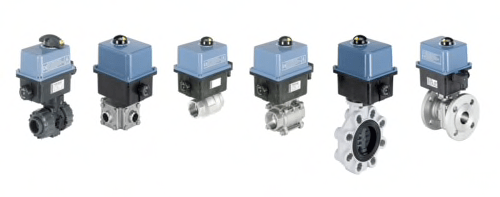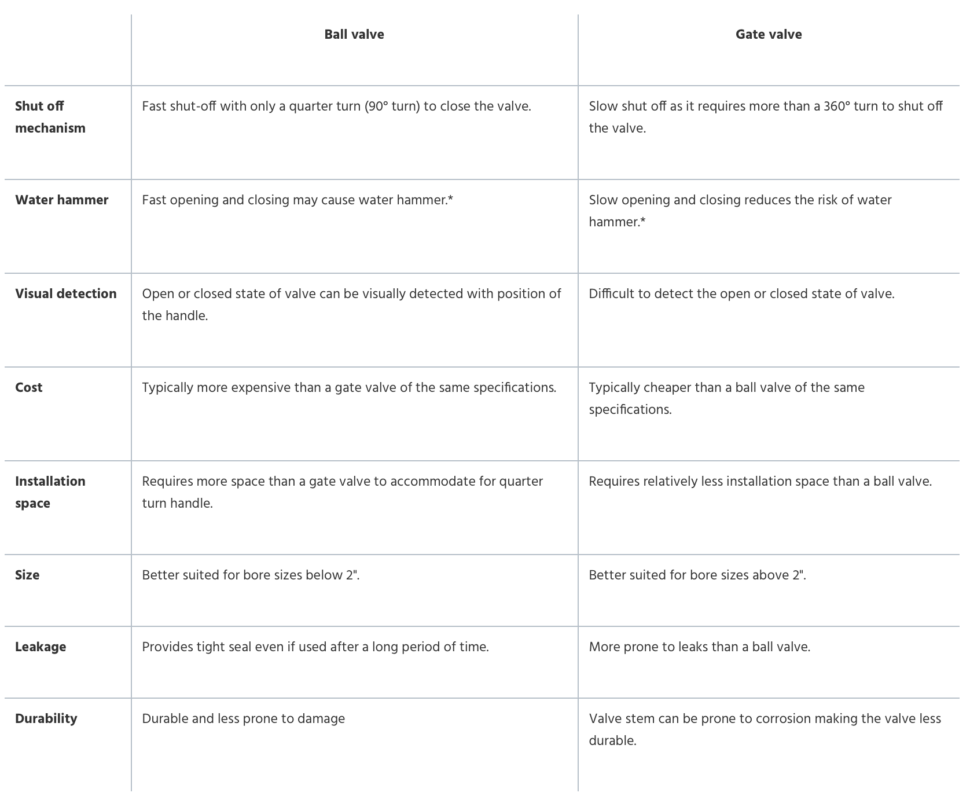Gate valves and ball valves are the most commonly used flow control valves in the industry. They are generally used to control the flow of liquids and gases. Although the valves used in similar settings, there are a few important differences between these two valves. We will discuss the differences between a gate valve and ball valve and how to choose between them.
Common Applications
Both ball valves and gate valves are commonly used in residential and industrial applications.
- Gate valves are generally found in older plumbing systems and in applications where frequent shut off is not required. Large water supply lines use gate valves due to their straight flow path and less flow restrictions. Ball valves are increasingly used in new plumbing systems with frequent shut off requirements.
- Gate valves are used for application with slurries and viscous media because they are easier to clean and maintain. Ball valves are not desirable because they are difficult to clean, and the slurry particles may damage the rotary ball.
- Gate valves are used in power plants, mining and water treatment applications which are high temperature and high-pressure environments.
- Ball valves are commonly used in fire protection systems and marine applications. They are best not used in food, beverage and pharmaceutical applications as ball valves are difficult to clean and may cause contamination.

What is the difference between gate valve and ball valve?
The main difference is in the operation. A gate valve moves a solid disk up and down to open/close the orifice. A ball valve rotates a ball, the orifice, with a bore in it 90° to open or close the valve.
Operation Differences
Ball Valve

A ball valve uses a rotary ball with a bore and a stem as seen in Figure 1. When the handle attached to the stem is turned, it rotates the ball to open or close the valve. This valve is also called a quarter turn valve because the handle only needs a 90° turn (quarter turn) to allow or block the flow of the media. The valve is open when the handle is parallel to the pipe and it is closed when the handle is perpendicular to the pipe.
Gate Valve

A gate valve uses a gate to control the flow of the media. A gate is a solid disk structure that is connected to the stem, as seen in Figure 2. The gate is lifted to open the valve and is returned down to its original position to close the valve. The valve is accompanied by a bonnet which when rotated controls the position of the gate. This valve is also called a multi turn valve because it takes more than a 360° turn to fully open or close the valve.
Selection Criteria
The following criteria can be considered before selecting between a ball valve and gate valve:
- Ports: A gate valve has 2 ports, while a ball valve can have more than 2 ports.
- Flow Capacity: A gate valve can provide larger flow capacity than a ball valve as they are typically offered in larger diameters.
- Opening and closing speed: A ball valve is better suited for applications that require faster opening and closing speed or during emergencies due to its quarter turn on/off operation. A gate valve requires more than a 360° turn, making it slower than a ball valve to operate.
- Sealing: A ball valve provides a tight seal and has complete shut off characteristics as compared to a gate valve. Therefore, ball valves are better suited for applications like natural gas where a proper seal long-term is important.
- Pressure: Both ball valves and gate valves are suitable for low pressure applications. However, for high pressure applications a gate valve is better suited. This is due to the fast opening/closing of the ball valve that may cause a water hammer.
- Cost: A ball valve is generally more expensive than a gate valve of the same specifications. However, a ball valve is typically more durable and requires less maintenance compared to a gate valve. So, a ball valve may be more economical long-term.
- Connection: The choice of connection to the pipe is an important factor for both valves.
A ball valve is more suitable for smaller flow rates, anything requiring more than 2 ports, or for durability or sealing concerns. A ball valve is used to control the flow and is usually used as a shut-off valve.

A gate valve is typically less expensive, requires less installation space, and is better for higher flow rates. A gate valve is ideal for applications that have slurries, large flow rates, is cost sensitive, and is used for shut off applications.

Advantages and Disadvantages

Reference: Tameson, Aignep, Burkert
สำหรับข้อมูลเพิ่มเติม โปรดติดต่อเรา:
โทร: 02-384-6060 | ไลน์: @flutech.co.th | อีเมล: [email protected] | เฟสบุ๊ค: @flutech.co.th










